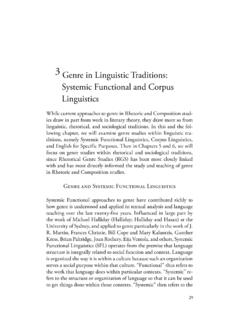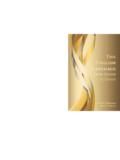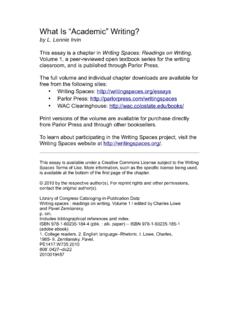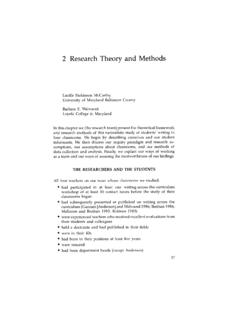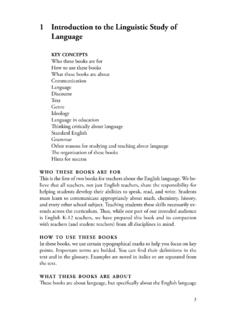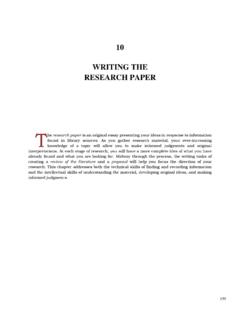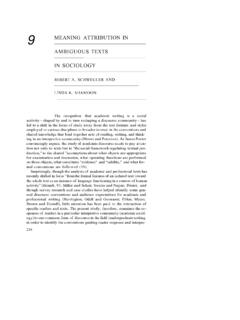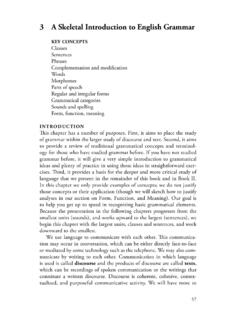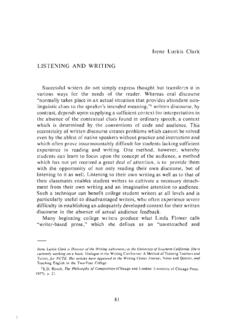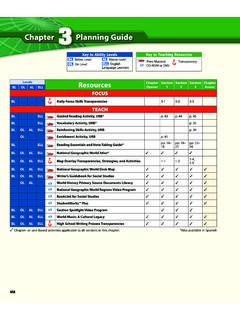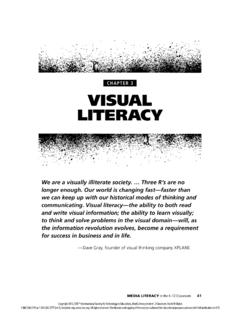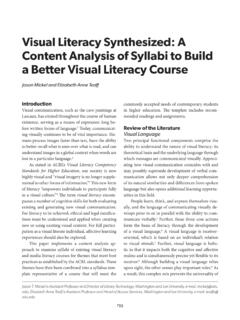Transcription of CHAPTER 3 AN ACTION RESEARCH INTERVENTION …
1 55 CHAPTER 3 AN ACTION RESEARCH INTERVENTION TOWARDS OVER- coming theory resistance IN photojournalism students Jennifer Good theory resistance What follows is an account of a small-scale ACTION RESEARCH INTERVENTION de-signed to tackle a problem I have called theory resistance , among undergraduate photojournalism students . By this I mean the resistance often expressed by these students to theoretical reading and writing, encountered in the required Con-textual Studies unit of their course (also called the History and theory unit). This is often related to a perceived or artificial polarization of theory and prac-tice. In this context, practice denotes the act of taking photographs, as opposed to the critical reading and writing that supplements and underpins this activity. Many students express a belief that this reading and writing is at best alienating and difficult, and at worst, a waste of time or a distraction from the real work of photography (see also Gimenez and Thomas CHAPTER 1, Adams CHAPTER 4 this volume).
2 ACTION RESEARCH is a process in which a specific problem is identified and an experimental INTERVENTION designed and tested with a view to gaining insight into the problem and ultimately solving it (John Elliott, 2001; David Kember, 2000). This particular INTERVENTION , undertaken at a large Arts and Design university in the United Kingdom, explored the experiences of students in reading weekly set critical texts for this unit in their second year. It is based on the pedagogic principle that effective engagement with such texts is crucial in students development as photojournalists, and that theory resistance is detrimental to their engagement with higher education as a whole, as well as to this photographic I have found that using metaphors is often helpful in explaining the value of critical texts, as well as how to tackle the reading involved imagery such as sieves, onions, chopsticks and maps, for example, can help illustrate selective or step-by-step approaches to reading I designed an INTERVENTION based on visualiza-56 Goodtion, in which students could collaboratively create visual models or metaphors by making simple drawings, and then discuss the implications of their drawings (Sarah Pink, 2006; Gillian Rose, 2007).
3 Arlene Archer (2006) argues that rather than being tied solely to verbal representation, academic literacies can and should account for other modalities, notably the visual . Visualizing ideas through drawing might be understood both as a way of communicating, inasmuch as visual literacy is an aca-demic literacy , and as a practice that might usefully cut through the power relations around difficult language, inasmuch as it transcends verbal language. This validation of a visual or pictorial approach is particularly useful among photojournalism stu-dents, who are often more comfortable communicating through (and about) images than words (see also Coleman CHAPTER 18, Stevens CHAPTER 19 this volume).The INTERVENTION was based upon the following hypotheses: 1) students would find drawing helpful in articulating their feelings about reading; 2) they would ben-efit from recognizing that they were not alone in their concerns; 3) they would be able to create models for more effective reading; and 4) I would learn from seeing how the students represented their struggles, enabling me to design better teaching and learning activities.
4 Of these hypotheses, the first, second and fourth were proved correct, while the third did not turn out as expected. Transformation for the teacher is a key part of the findings of my ACTION RESEARCH . More important than this however is the movement for students from resistance to acceptance of the contribution that reading theoretical texts can make to their practice as photographers, and also from a place of intimidation and shame in the face of difficult theoretical language to empowerment and (following bell hooks, 1994) freedom. In this process, the atmo-sphere within the teaching space is completely transformed, as trust is built between teacher and students through making explicit the tacit oppression of ON/AS AN ACADEMIC LITERACIES APPROACHS tudents embark on the BA (Hons) photojournalism course with a view to becoming photographers: from the beginning of the course they are practitioners of photography first and foremost, rather than writers or theorists.
5 My approach in teaching theory must be sensitive to this. I aim to encourage students to take what they need from texts to gain the confidence to be selective in what they read based on their own interests and practice, without being dismissive of the rest. There are a number of hurdles involved in this. My view is that while it tends to manifest itself as a dismissal of the value of theory , theory resistance is most often rooted in a lack of confidence; a belief that critical texts are too difficult, provoking a defensive and/or fearful reaction. The academic literacies model provides a frame-work for acknowledging the pressure faced by students as they negotiate unfamiliar literacy practices (Mary Lea & Brian Street, 1998). These are understood as social 57An ACTION RESEARCH Interventionpractices that often maintain relationships of power and authority (ibid., p. 168). A key element distinguishing the academic literacies model as the basis for this INTERVENTION is its attention to the problem of tacit-ness or implicitness, which is rooted in power relations: the student experience of having to adapt to academic language is often stressful, and as Lea and Street (1998, p.)
6 2006) argue, teachers of-ten fail explicitly to acknowledge this, instead maintaining a tacit expectation that students must either navigate these differences independently or fail to progress. students thus either occupy a privileged position inside, with access to academic discourse, or are excluded and disempowered, particularly in relation to the teacher. theory resistance is an understandable response to this situation, in which, accord-ing to the academic literacies model, there is a clear need to make tacit assumptions about academic language more explicit, and to find ways of empowering students in relation to language. Tamsin Haggis suggests that collective inquiry open dialogue or negotiation between students and teachers is one important way of working at this empowerment (2006, p. 8).Feeling that a text is too hard is one issue. Another, which I encounter frequent-ly among students , is that it is irrelevant. Writing in the context of feminism, bell hooks spells out the urgent political stakes implicit in this assumption, explaining how language can widen the perceived theory /practice gap in dangerous ways:many women have responded to hegemonic feminist theory that does not speak clearly to us by trashing theory , and, as a conse-quence, further promoting the false dichotomy between theory and practice.
7 By internalizing the false assumption that theory is not a social practice, they promote .. a potentially oppressive hierarchy where all concrete ACTION is viewed as more important than any theory written or spoken. (hooks, 1994, pp. 66-67)The complexity of theoretical language is often seen by photojournalism stu-dents as a sign that it is not useful; that it is firmly divided from practice or con-crete ACTION . hooks presents this in hierarchical terms that arguably contrasts with what Lea and Street say about power relationships, highlighting a tricky double standard: students recognize that some types of language are of a higher, more exclusive order than others. They often conclude, however, as a direct consequence of this, that academic language is not valuable. Rather than aspiring to be part of the conversation, they reject it in principle because of its very exclusivity; objecting to an oppression which in part they themselves are implicated in constructing.
8 Hooks work signals a valuable link that needs to be made between academic lit-eracies work which centers primarily on language and literacy with other fields in which there is an essential relationship between political activism and theory , such as feminism, and, indeed, ACTION RESEARCH INTERVENTIONThe ACTION RESEARCH INTERVENTION involved gathering data over the course of one ten-week term. In keeping with an ACTION RESEARCH approach, this data took a num-ber of forms. It included drawings, questionnaires and detailed notes made in the course of a number of sessions in which I recorded what students week one of the autumn term, I asked the students to read a fairly complex CHAPTER from Roland Barthes s (1977) book, Image Music Text. The following week I conducted two identical hour-long sessions with the two halves of the student cohort. Each began with an informal discussion about the experience of reading the text, during which I noted particularly how it had made the students feel.
9 I then introduced the concept of academic literacies, firstly by explaining that in academic reading and writing, power relations are in play because of the power that language has to both include and exclude; and secondly that an important step in addressing this power imbalance is to have an explicit, clear and inclusive discussion about such issues rather than leaving them unspoken. I explained my belief that creating visual models of what difficult academic reading looks like might be helpful, and that it was important that we do this collaboratively, to explode the myth that, I m the only one who doesn t get it. I asked the students , in collaborative groups of four or five, first to draw their negative experiences of reading the Barthes text, visualizing what it was like. I then asked them to imagine and draw a more positive reading experience. Overall, twen-ty-four drawings were made in the course of the two sessions, using colored marker pens on A2-sized paper.
10 In some cases the collaboration involved one student doing the drawing based on suggestions and directions by others; in other cases several students worked on different parts of the drawing at once, or added elements one after another as ideas developed. We then discussed the drawings, and in the weeks that followed I asked the students questions about how this exercise had affected their experience of reading, recording their answers in my notes. Most importantly: How did they approach/tackle the text(s)? How did it feel? In the final week students filled in an anonymous questionnaire about the term s reading experiences FINDINGS: DRAWING READINGWhen reflecting on the initial experience of reading a difficult text, students comments, which I noted during our group discussion, ranged from the very emo-tional I felt stupid , it made me angry to critical judgments about the text itself I felt it was badly written , there was too much assumed prior knowledge 59An ACTION RESEARCH Interventionof words and concepts and accounts of strategies that they used to try to tackle the text.
